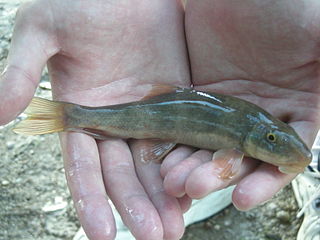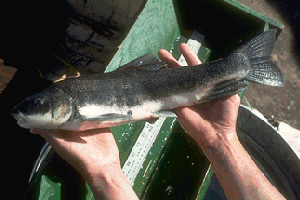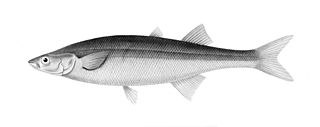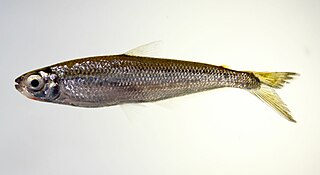The Percopsiformes are a small order of ray-finned fishes, comprising the trout-perch and its allies. It contains just ten extant species, grouped into seven genera and three families. Five of these genera are monotypic.

Pollock or pollack is the common name used for either of the two species of North Atlantic marine fish in the genus Pollachius. Pollachius pollachius is referred to as pollock in North America, Ireland and the United Kingdom, while Pollachius virens is usually known as saithe or coley in Great Britain and Ireland. Other names for P. pollachius include the Atlantic pollock, European pollock, lieu jaune, and lythe; while P. virens is also known as Boston blue, silver bill, or saithe.

The Percidae are a family of ray-finned fish, part of the order Perciformes, which are found in fresh and brackish waters of the Northern Hemisphere. The majority are Nearctic, but there are also Palearctic species. The family contains more than 200 species in 11 genera. The perches and their relatives are in this family; well-known species include the walleye, sauger, ruffe, and three species of perch. However, small fish known as darters are also a part of this family.

Arowanas are freshwater bony fish of the subfamily Osteoglossinae, also known as bony tongues. In this family of fish, the head is bony and the elongated body is covered by large, heavy scales, with a mosaic pattern of canals. The dorsal and anal fins have soft rays and are long based, while the pectoral and ventral fins are small. The name "bonytongues" is derived from a toothed bone on the floor of the mouth, the "tongue", equipped with teeth that bite against teeth on the roof of the mouth. The arowana is a facultative air breather and can obtain oxygen from air by sucking it into its swim bladder, which is lined with capillaries like lung tissue.
Lepisosteus is a genus of gars in the family Lepisosteidae.

Sphyrna is a genus of hammerhead sharks with a cosmopolitan distribution in the world's oceans. Members of Sphyrna have a tendency to inhabit coastal waters along the intertidal zone rather than the open ocean, as their prey such as invertebrates, fish, rays, small crustaceans, and other benthic organisms hide in the sands and sediment along these zones. Members of Sphyrna are also known by synonyms such as Zygaena, Cestracion, and Sphyrichthys. The earliest species described of this genus was Sphyrna zygaena by Carl Linnaeus in 1758, while the latest described member, Sphyrna gilberti, was discovered and described in 2013.

Catostomus is a genus of fish belonging to the family Catostomidae, commonly known as suckers. Most members of the genus are native to North America, but C. catostomus is also found in Russia. Fish from different species of the genus are known to readily hybridize with each other.

Laetacara is a small genus of cichlids native to freshwater habitats in tropical and subtropical South America, ranging from the upper Orinoco River basin in Venezuela to the Paraná River basin Argentina. The genus is also collectively known as the smiling acaras. Like all cichlids, Laetacara species have well-developed brood care.

Agamyxis is a genus of thorny catfishes.

Chasmistes is a genus of ray-finned fish in the family Catostomidae.

Cyprinella is a genus of fish in the family Cyprinidae, the carps and minnows. They are known as the satinfin shiners. They are native to North America, and some are among the most common freshwater fish species on the eastern side of the continent. Conversely, several Cyprinella species with small distributions are threatened and the Maravillas Creek subspecies of the red shiner is extinct.

Basilichthys australis is a species of Neotropical silverside fish which ist endemic to Chile from the Rio Maipo south to Chiloé Island.

Basilichthys microlepidotus is a species of Neotropical silverside endemic to Chile. It s a pelagic freshwater species which occurs from the Huasco River to Valparaiso.

Osmerus is a genus of smelt.

Atractosteus is a genus of gars in the family Lepisosteidae, with three species. The genus first appeared in the Campanian in the Late Cretaceous.

Odontesthes is a genus of Neotropical silversides. They are found in fresh, brackish and salt water habitats in the southern half of South America, as well as the offshore Juan Fernández and Falkland Islands. Additionally, O. bonariensis has been introduced to other continents.

Chalceus is a genus of fish that inhabits freshwater habitats in South America. Members can be found in the Amazon and Orinoco basins, as well as in the Guianas and various tributaries of the former. It is the sole representative of the family Chalceidae.

Iguanodectes is a genus of freshwater fish found in tropical South America, with eight currently described species. They are all small tetras, none longer than 5 inches, and often have attractive silvery or striped scales, which makes them a target for the ornamental fish industry. Alongside the genus Piabucus, it is in the subfamily Iguanodectinae, which in turn is in the family Iguanodectidae. The genus Bryconops, which is also in Iguanodectidae, makes up a sister clade to Iguanodectinae.

Atherinopsinae is a subfamily of the Neotropical silversides, part of the family Atherinopsidae. This subfamily is made up of two tribes, six genera and around 30 species. They are found in the eastern Pacific and south-western Atlantic and the subfamily contains marine, brackish and freshwater species.

Chalceidae, the tucanfishes, is a family of freshwater fish first described by Henry Weed Fowler in the year 1958. It is a monotypic family, home only to the genus incertae sedisChalceus.

















